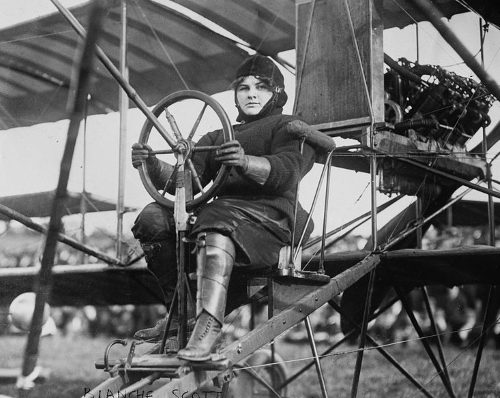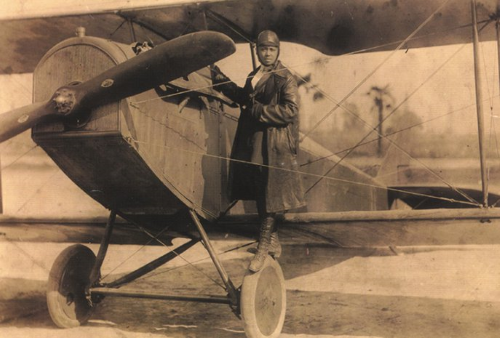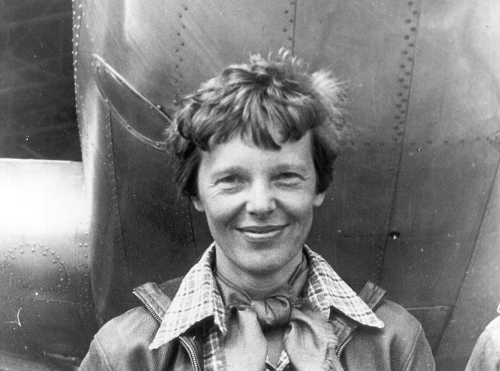Women have been involved with aviation since the Wright Brothers’ first brief flight in 1903.
Although Katherine Wright didn’t fly with her brothers until 1909, she supported them both financially and emotionally, eventually becoming their social manager in Europe, and knew everything about the workings of their early airplanes.
Blanche Scott claimed to be the first female pilot in 1910 after a strong wind briefly took the plane she was taxiing up into the air, but this unintentional flight went unrecognized.
Related Article – 14 Taxiway Markings, Signs, and Lights Explained By An Actual Pilot

However, Scott went on to become a daredevil pilot, competing in air shows, exhibitions, and flying circuses.
In August of 1911, Harriet Quimby became the first licensed female pilot in America.
The following year she became the first woman to cross the English Channel by plane.
Bessie Coleman was the first African-American woman to earn a pilot’s license in 1921.

Due to the discrimination she faced in the US, Coleman moved to France and attended their most prominent flight school before returning to America.
In the 1920’s, many women became interested in air shows and competitions.
As male pilots often didn’t want to compete with women, all-female air races were organized.
The most well-known of these was the 1929 National Women’s Air Derby.
This, too, was unpopular, with sabotage threats made to the race organizers, and headlines declaring the race should be halted.
Meanwhile, the male organizing committee tried to relocate the starting point to Omaha, Nebraska, because they didn’t think women could fly over the Rockies.
Related Article – 12 Runway Markings and Signs Explained By An Actual Pilot
But the Derby went on and women across the country attended, racing from Santa Monica, California to Cleveland, Ohio in eight days.
Louise Thaden won the race.
Once the race was over, many of the participants wanted to form a club for female pilots.
Clara Trenckmen, who worked for Curtiss Flying Service at Valley Stream, set up an invitation-only meeting at a Curtiss Field hangar in November of 1929.
Thanks to a suggestion from Amelia Earhart, they named their new club “The Ninety-Nines” after the 99 of 117 licensed female pilots who became charter members.

Earhart, the first female aviator to make a solo flight across the Atlantic, was elected their first president.
The New York Times reported on this meeting by saying, “The women are going to organize. We don’t know what for.”
Many of the club’s early efforts centered around recruiting more members and holding races, as women continued to be shut out of equal competition with male pilots.
They were also limited to less powerful planes (an “appropriate” horsepower decided by men) and required to take a male “medical representative” on flights.
The Ninety-Nines also fought the US government’s proposed ban on “flying during menstruation,” because men in government believed a woman’s ability to fly a plane was somehow reduced during this time.
Eventually the government caved and agreed to drop the ban proposal, but these bizarre and erroneous ideas about menstruation and flying persisted for years, even haunting female applicants in the beginning years of the space program.
In the early years of flying, pilots had difficulty with navigation and knowing where they were.
Related Article – Airline Transport Pilot Certificate (ATP): 4 Things You Need To Know
Navigation instruments and radios often weren’t available for civilians, and the national airways system we have today didn’t exist yet, making it difficult for pilots to know their location.
Pilot and Ninety-Nines member Phoebe Omlie was named Special Assistant for Air Intelligence of the National Advisory Committee for Aeronautics in 1934.
She convinced government officials to use WPA (Works Progress Administration) funds and help from the Ninety-Nines for the Air Marking Project.
They divided states into 20-square-mile sections.
Then, the name of the nearest town was painted on the top of prominent buildings.
If there were no significant buildings, they used ground markers made from stone or other materials.
This was the first time a government program had been conceived, planned, and executed solely by women, and it was a huge success.
The Air Marking Project continues today.
During World War II, the markers had to be taken down temporarily due to concerns about enemy invasion.
Meanwhile, many of the Ninety-Nines served in the war effort, in the Women’s Auxiliary Ferrying Squadron or Women’s Airforce Service Pilots.
Ruth Cheney Streeter, a member of the Ninety-Nines, became the head of the Women’s Marine Corp, while many pilots with nursing experience created the field of flight nursing.
Civilian members of the Ninety-Nines also took on roles more commonly reserved for men at the time—air traffic controllers, flight instructors, and commercial airline pilots.
After World War II, women who had begun working in previously male-dominated fields, including aviation, were expected to return to traditional gender roles in the home, but many didn’t want to.
The Ninety-Nines returned to organizing races, and throughout the decades, advocated for their members’ needs as female pilots.
In 1959, Geraldine Cobb became the first woman to undergo testing for the Mercury spaceflight missions.
At 28, she had 7,000 hours of flight time and held three world records for her flying.
Related Article – Instrument Proficiency Check (IPC): 4 Things You Need To Know
Cobb and twelve other women successfully completed all the psychological and physical tests for the program, but NASA refused to let them continue because they didn’t want to appear to approve of female astronauts.
It wasn’t until June of 1983 that Dr. Sally Kristen Ride became the first woman in space on a six-day mission of the orbiter Challenger.
In 2019, astronauts Christina Koch and Jessica Meir completed the first all-female spacewalk.
See Also:
Choosing A Flight School Near You
